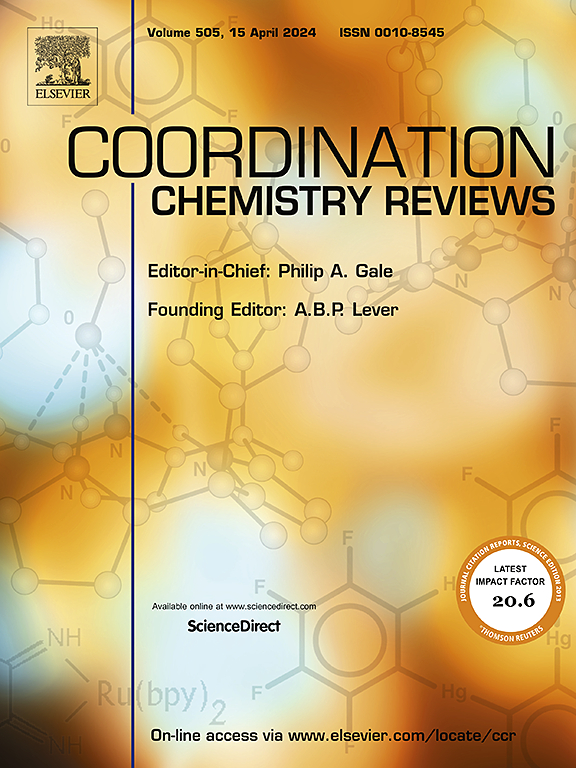基于金属-有机框架的双模生物传感器:机制与应用
IF 20.3
1区 化学
Q1 CHEMISTRY, INORGANIC & NUCLEAR
引用次数: 0
摘要
为了解决日益复杂的检测场景,生物传感技术正在从单模态向双模态系统过渡。金属有机骨架(mof)以其高表面积、可调节的孔隙结构和多功能特性,成为双模生物传感器的理想基板。它们的优点包括:(1)金属节点和配体之间精确设计的配位可以实现协同的光电电化学信号输出;(2)内在的类酶或光/电催化活性(当存在时)可以通过底物转化放大检测信号;(3)模块化设计允许同时集成信号转导和催化功能,在适用的情况下,建立强大的传感协同作用。该技术已成功应用于生物分子、病原体、生物毒素、农药、重金属和新兴污染物的检测。目前的研究主要集中在结构-活性优化方面,但仍存在一些挑战,如基质干扰和稳定性问题。未来的努力需要跨学科合作来开发智能MOFs、微纳集成系统和实际验证。本文系统分析了用于双模生物传感器的mof的合成策略、传感机理、当前挑战和未来展望,为高精度生物传感平台的设计提供理论和技术指导。本文章由计算机程序翻译,如有差异,请以英文原文为准。
Metal–organic framework-based dual-mode biosensors: Mechanisms and applications
To address the growing complexity of detection scenarios, biosensing technology is transitioning from single-modal to dual-mode systems. Metal-organic frameworks (MOFs), with their high surface area, tunable pore structures, and multifunctional properties, have emerged as ideal substrates for dual-mode biosensors. Their advantages include: (1) precisely engineered coordination between metal nodes and ligands enables synergistic optical-electrochemical signal outputs; (2) intrinsic enzyme-like or photo/electrocatalytic activities (when present) can amplify detection signals through substrate conversion; (3) modular design allows simultaneous integration of signal transduction and, where applicable, catalytic functions, establishing a robust sensing synergy. This technology has been successfully applied in detecting biomolecules, pathogens, biotoxins, pesticides, heavy metals, and emerging contaminants. Current research focuses on structure-activity optimization, yet challenges remain, such as matrix interference and stability issues. Future efforts require interdisciplinary collaboration to develop intelligent MOFs, micro-nano integrated systems, and practical validation. This review systematically analyzes the synthetic strategies of MOFs for dual-mode biosensors, sensing mechanisms, current challenges, and future prospects, thereby providing theoretical and technical guidance for the design of high-precision biosensing platforms.
求助全文
通过发布文献求助,成功后即可免费获取论文全文。
去求助
来源期刊

Coordination Chemistry Reviews
化学-无机化学与核化学
CiteScore
34.30
自引率
5.30%
发文量
457
审稿时长
54 days
期刊介绍:
Coordination Chemistry Reviews offers rapid publication of review articles on current and significant topics in coordination chemistry, encompassing organometallic, supramolecular, theoretical, and bioinorganic chemistry. It also covers catalysis, materials chemistry, and metal-organic frameworks from a coordination chemistry perspective. Reviews summarize recent developments or discuss specific techniques, welcoming contributions from both established and emerging researchers.
The journal releases special issues on timely subjects, including those featuring contributions from specific regions or conferences. Occasional full-length book articles are also featured. Additionally, special volumes cover annual reviews of main group chemistry, transition metal group chemistry, and organometallic chemistry. These comprehensive reviews are vital resources for those engaged in coordination chemistry, further establishing Coordination Chemistry Reviews as a hub for insightful surveys in inorganic and physical inorganic chemistry.
 求助内容:
求助内容: 应助结果提醒方式:
应助结果提醒方式:


